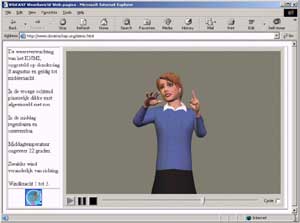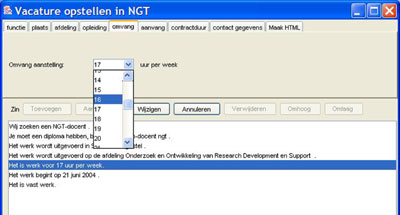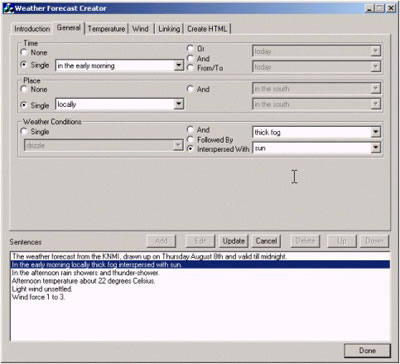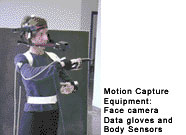
| Homepage » Research » Speech, Language and Virtual Humans » Virtual Humans » Multilingual Sign Language Content Creation » Structured Content Generation |
Structured Content Generation |
There are many web pages where, while the content changes frequently, the format of the page remains the same. An example is the Weather Forecast and a Weather Forecast Creator, developed as part of the ViSiCAST Project. This facilitated the daily generation of weather forecast web pages that included a signed version of the information for deaf people. The signing was done by an Avatar, or virtual human. This model has been extended as part of the eSIGN Project to produce a generic Structured Content Generation Tool, which is easily modified to update the content of any specific web page. Both Tools are capable of creating output in three different sign languages and text versions, simultaneously. |
||
| Weather Forecast Creator |
 |
|
|
With the structure in place, the written language version could be mapped to previously recorded sign language files capable of driving the Avatar. The recorded sign language files were obtained by tracking the motions of an experienced signer using an optical system for tracking facial expression, a magnetic body suit for posture, and data gloves for hand and finger shapes. The signer’s movements were captured at a very high resolution (far higher than is usually used for animation or video games). This is important for the generation of animated sign language, where even the slightest difference in speed, direction or gesture has a bearing upon meaning. Signs of three different sign languages were captured: Sign Language of the Netherlands, German Sign Language and British Sign Language, each with native signers. The signs were post-edited to correct shapes or gestures that may have been performed or recorded inaccurately. Real-time visualisation software was used blend one captured sequence into another, on the resultant web pages creating a smooth signed performance – something that would be unachievable with joined-up clips of video. |
| Developments From this, the idea of a generic program for such content creation evolved. All aspects of the domain would be represented as an XML description file and passed to the core program as input. This would include not only the entire list of contents which could be selected, but also the GUI used to enable the selection. The XML would require some degree of expertise to set up, but considerably less than that needed to write an entirely new program. The core program itself remains the same. |
 |
|
 |
||
It would also be possible to modify output from the Tool if the need arose, for example, if versions in more than one language were required, or to restructure any text output from the Tool. This could be achieved by the use of XSLT stylesheets. The fact that the ViSiCAST Weather Forecast Creator was written in C++, restricted its use to Windows and PC machines. For applications to be available to a wider number of users, not least members of the eSIGN project itself, it should be written in a language that is less platform-dependent. Java was chosen to facilitate this. Further advancements in the Avatar technology meant that motion capture was no longer needed in order to describe the movements the Avatar made. Now, the description of movement was entirely synthetically generated. Further details can be found on the eSIGN project pages As part of eSIGN, the Tool was used to develop Job Vacancy web pages which included signed versions of the text. As with all web pages which use the Avatar signing, it is necessary to install the Avatar software on the user's computer to view the pages. |
||
|
|||||||||||||
+44 (0)1603 592847 +44 (0)1603 593345 www-admin@cmp.uea.ac.uk |

